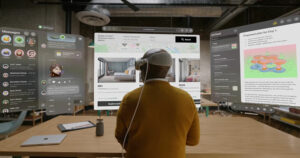
Over half a million copies of the developer preview of Windows 8 have been downloaded, according to Microsoft, giving app makers around the world a sample of the software maker’s upcoming operating system.
Those developers, though, may have to go through a learning curve if they want to build Windows 8 tablet apps.
The tablet versions of Windows 8 apps will be built for the OS’s Metro user interface, and the Metro version of the Internet Explorer browser will not include Flash or other plug-ins. Further, they will run on devices powered by ARM processors, while the desktop version of Windows 8 will run on x86 PCs.
That means developers will have to create two versions of Windows 8 apps if they want them to run across the two different platforms.
“Developers will have to choose whether their apps need to be touch-enabled, in which case they should choose Metro, or whether the app requires a mouse interface for precision tasks such as computer-aided design and pixel manipulation, in which case they should choose the desktop version of Windows 8,” Al Hilwa, a program director at IDC, told TechNewsWorld.
However, the lack of Flash support in Metro will not be a problem because “Windows apps today do not use Flash; they’re written in native languages on Windows,” Hilwa said.
Microsoft spokesperson Annie Truong declined TechNewsWorld’s request for further comment.
The Perils of Win 8 App Development
Appdevs will have to go through a learning curve in order to create mobile Win 8 apps, IDC’s Hilwa said.
“Apps targeting a touch interface require special style guidelines and rules that are different from those for desktop apps,” Hilwa explained.
For example, Windows 8’s Metro UI does not support overlapping windows, and it doesn’t have all the interfaces for supporting these, Hilwa pointed out. “This means there are different ways of doing things that will require Windows UI developers to learn new tricks,” he added.
The additional learning curve weighed on the minds of Windows devs, who raised their concerns after Microsoft previewed Windows 8 at the D9 conference in June.
Their fear was that they’d have to abandon Visual Basic, .NET, Silverlight and other languages with which they’d learned to create apps in for Windows.
Further, they were concerned that they’d have to compete with Web-based developers rushing into the market.
Failure to Communicate?
The question of whether or not applications created for the x86 platform can run on ARM devices led to a row between Microsoft and Intel back in May.
Renee James, head of Intel’s software business, had suggested that Microsoft might create multiple versions of Windows 8, four of which would work on ARM processors and wouldn’t run legacy applications.
Microsoft blasted that comment as inaccurate and misleading, and Intel said that the number four was arbitrary.
Microsoft’s statements at the BUILD conference Tuesday may not have done much to clarify the matter.
Announcing Windows 8 Tuesday, Steven Sinofsky, president of Microsoft’s Windows Division, had stated that apps developed for Windows 8 would run on both x86 and ARM platforms, and demonstrated that it was easy to convert desktop apps to Metro apps.
Microsoft’s subsequent press release further strengthened that impression. It stated that the Metro style user interface is equally at home on touchscreens and with a mouse and keyboard and that Windows 8 would support ARM-based and x86 devices.
Sinofsky also stated that Microsoft app devs can leverage their existing skills in C# and other development languages they already know to create Windows 8 apps.
However, he told financial analysts Wednesday that x86 apps will not run on ARM devices and that cross-compatibility for Win 8 apps will not be practical, Information Week reported.






















































Having tried Windows 8 on my Desktop PC. I have to conclude that Microsoft has a dud on its hands. While Metro seems a OK fit for a Tablet or Phone. Its dreadful on a PC with a Mouse and Keyboard.
This has nothing to do with fickle drivers or a un polished OS. Its just the basic concept is wrong on a PC. I remember back to Steve Jobs who was asked why Mac’s don’t apply a Touch screen on their iMac’s for example. He replied that Touch screens on a vertical screen such as a desktop don’t work. He is right! They don’t.
I think Microsoft made a mistake employing too much Touch screen UI into a PC OS. Apple has tried on a lessor level to employ some IOS features. Such as Launchpad. But its not taking away from the traditional UI. You can use it or not. Microsoft is going to have to make Metro somehow optional in order to keep users who like the traditional UI happy.